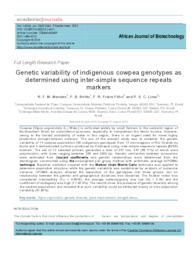Genetic variability of indigenous cowpea genotypes as determined using inter-simple sequence repeats markers.
Genetic variability of indigenous cowpea genotypes as determined using inter-simple sequence repeats markers.
Autoria: MENDES, R. F. M.; BRITTO, F. B.; FREIRE FILHO, F. R.; LIMA, P. S. da C.
Resumo: Cowpea [Vigna unguiculata (L.) Walp.] is cultivated widely by small farmers in the semiarid region of Northeastern Brazil for subsistence purposes, especially to complement the family income. However, owing to the limited availability of water in this region, there is an urgent need for novel highly productive drought-tolerant cultivars. The aim of the present study was to establish the genetic variability of 14 cowpea populations (60 indigenous genotypes from 13 microregions of Rio Grande do Norte and 4 domesticated cultivars produced by Embrapa) using inter-simple sequence repeats (ISSR) markers. The set of 13 selected primers generated a total of 257 loci, 247 (96.11%) of which were polymorphic, with sizes ranging between 200 and 2000 bp. Genetic similarities between accessions were estimated from Jaccard coefficients and genetic relationships were determined from the dendrogram constructed using the unweighted pair group method with arithmetic average (UPGMA) technique. Bayesian statistics coupled with the Markov chain Monte Carlo technique was applied to determine population structure, while the genetic variability was established by analysis of molecular variance. UPGMA analysis allowed the separation of the genotypes into three groups, but no relationship between the genetic and geographical distances was observed. The fixation index was considered intermediary (FST = 0.0818), the average heterozygosity was low (HS = 0.39) and the coefficient of endogamy was high (f = 92.6%). The results show the presence of genetic diversity among the studied populations and revealed that such variability could be attributed mainly to intra-population variability (91.82%).
Ano de publicação: 2015
Tipo de publicação: Artigo de periódico
Unidade: Embrapa Amazônia Oriental
Observações
1 - Por padrão são exibidas publicações dos últimos 20 anos. Para encontrar publicações mais antigas, configure o filtro ano de publicação, colocando o ano a partir do qual você deseja encontrar publicações. O filtro está na coluna da esquerda na busca acima.
2 - Para ler algumas publicações da Embrapa (apenas as que estão em formato ePub), é necessário ter, no celular ou computador, um desses softwares gratuitos. Sistemas Android: Google Play Livros; IOS: iBooks; Windows e Linux: software Calibre.
Acesse outras publicações
Acesse a Base de Dados da Pesquisa Agropecuária (BDPA) para consultar o acervo completo das bibliotecas da Embrapa.

